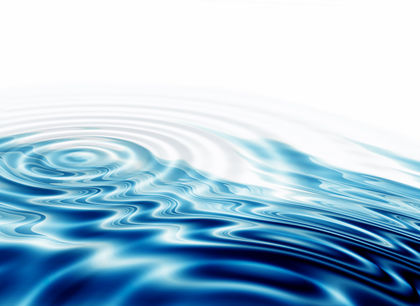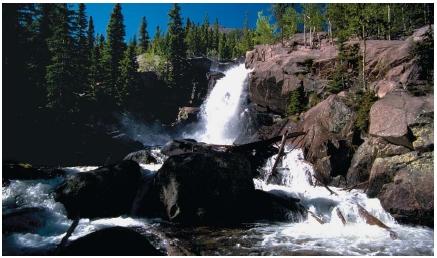Water

Water is an odorless, tasteless, transparent liquid that appears colorless but is actually very pale blue. The color is obvious in large quantities of water such as lakes and oceans. Water is the most abundant liquid on Earth. In its liquid and solid (ice) form, it covers more than 70 percent of Earth's surface—an area called the hydrosphere.
Earth's supply of water is constantly being replaced through a natural cycle called the hydrologic cycle. Water is continually evaporating from the surface of the planet, condensing in the atmosphere, and falling back to the surface as precipitation.
It is impossible to overstate the importance of water to almost every process on Earth, from the life processes of the lowest bacteria to the shaping of continents. Water is the most familiar of all chemical compounds known to humans. In fact, the human body is composed mainly of water.
Chemical properties of water
Water is a single chemical compound whose molecules consist of two hydrogen atoms attached to one oxygen atom. The chemical formula of this compound is H 2 O. Considering that a hydrogen atom weighs only about one-sixteenth as much as an oxygen atom, most of the weight in water is due to oxygen: 88.8 percent of the weight is oxygen and 11.2 percent is hydrogen. This percentage remains the same from a single water molecule to a lake full of water molecules.
Water can be made (synthesized) from hydrogen and oxygen, both of which are gases. When these two gases are mixed, however, they do not react unless the reaction is started with a flame or spark. Then they react with explosive violence. The tremendous energy that is released is a signal that water is an extremely stable compound. It is hard to break a water molecule apart into its components.
The normal boiling point of water is 212°F (100°C) and its freezing point is 32°F (0°C). As water is cooled to make ice, it becomes slightly denser, like all liquids. But at 39.2°F (4°C), it reaches its maximum density. When cooled below that temperature, it becomes less dense. At 32°F (0°C), water freezes and expands. Since ice is less dense than water, ice floats on it.
In pure water, 1 out of every 555 million molecules is broken down into a hydrogen ion and a hydroxide ion (an ion is an electrically charged atom or group of atoms). These ions are enough to make water a slight conductor of electricity. That is why water is dangerous when there is electricity around.
Because water dissolves so many substances (it is called the universal solvent), all of the water on Earth is in the form of solutions.
Words to Know
Aquifer: Underground layer of sand, gravel, or spongy rock that collects water.
Estuary: Lower end of a river where ocean tides meet the river's current.
Hydrologic cycle: Continual movement of water from the atmosphere to Earth's surface through precipitation and back to the atmosphere through evaporation and transpiration.
Ion: A molecule or atom that has lost one or more electrons and is, therefore, electrically charged.
Saltwater
The oceans contain more than 97 percent of all the water on Earth. However, seawater is unsuitable for drinking because of the large amount of dissolved salts in it. The six most abundant elements making up these salts in seawater are chlorine, sodium, sulfur, magnesium, calcium, and potassium. Chlorine and sodium, the most abundant of these elements, combine to form sodium chloride, more commonly known as table salt.
These elements are deposited in seawater through various means. Volcanic activity (on land and on the seafloor) releases chlorine and sulfur. Other elements reach the oceans through runoffs from land. Rain and other precipitation weathers and erodes rocks and soil on land, dissolving the minerals (salts) they contain. This material is then transported to the oceans by rivers.
Salinity is the measure of the amount of dissolved salts in seawater. This measurement is usually the mass of material dissolved in 1,000 grams (35 ounces) of water. The average salinity of seawater is about 35 grams (1.2 ounces) of salts in 1,000 grams (35 ounces) of seawater, or 3.5 percent of the total.
Hard Water
Hard water is water that contains large amounts of ions (electrically charged particles) of calcium, magnesium, or iron. Hard water often has an unpleasant taste, interferes with the ability of soaps to dissolve, and can cause scaling (the building up of insoluble material) in pipes and hot water systems.
Water hardness is most commonly the result of acidic water containing carbon dioxide passing through limestone or dolomite and dissolving the minerals these rocks contain. The dissolved minerals lead to an increase in the amounts of calcium and magnesium ions in the water.
Hard water can be treated by boiling the water, but this method is effective only for small quantities. A more efficient method is to use ion-exchangers, in which the unwanted calcium and magnesium ions are exchanged or traded for sodium ions that do not cause scaling. Most water softeners work by the ion-exchange method. The soft water that is produced is not free of ions, only of undesirable ions.
Desalination. Desalination is the process of removing salt from sea-water to provide essential water for drinking, irrigation, and industry, especially in desert regions or areas where freshwater is scarce. In the almost 4,000 desalination plants worldwide, most desalination takes place through two methods: distillation and reverse osmosis.
At its simplest, distillation consists of boiling seawater to separate it from dissolved salt. Once the seawater boils, water vapor rises, leaving the salt on the bottom of the tank. The water vapor is then transferred to a separate, cooler tank where it condenses as pure liquid water. Heat for distillation usually comes from burning fossil fuels (oil and coal). Distillation is widely used in the Middle East, where fossil fuel is plentiful but freshwater is scarce.
Reverse osmosis uses high pressure to force pure water out of saltwater. Pressures up to 60 atmospheres (800 to 1,200 pounds per square inch) are applied to saltwater, forcing it through a special membrane that allows only pure water to flow through, trapping the salt on the other side. Reverse osmosis is widely used to desalinate brackish water, which is less salty than seawater and therefore requires pressures only about one-half as great.
Brackish water
Brackish water has a salinity between that of freshwater and seawater. Brackish waters develop through the mixing of saltwater and freshwater. This occurs mostly near the coasts of the oceans in coastal estuaries (the lower course of a river where it flows into an ocean) or salt marshes that are frequently flooded with ocean currents due to the rising and falling of tides.

Most species can tolerate either saltwater or freshwater, but not both. Organisms that live in brackish habitats must be tolerant of a wide range of salt concentrations. The small fish known as killifish are common residents of estuaries, where within any day the salt concentration in tidal pools and creeks can vary from that of freshwater to that of the open ocean. During their spawning migrations, salmon and eels experience a range of salt concentration as they move through all three water environments: seawater, brackish water, and freshwater.
Freshwater
Freshwater is chemically defined as water that contains less than 0.2 percent dissolved salts. Of all the water on Earth, less than 3 percent is freshwater. About two-thirds of all freshwater is locked up in ice, mainly in Greenland and the Antarctic.
The remaining freshwater—less than 1 percent of all the water on Earth—supports most plants and animals that live on land. This freshwater occurs on the surface in lakes, ponds, rivers, and streams and underground in the pores in soil and in subterranean aquifers in deep geological formations. Freshwater also is found in the atmosphere as clouds and precipitation.
Worldwide, agricultural irrigation uses about 80 percent of all freshwater. The remaining 20 percent is used for domestic consumption, as cooling water for electrical power plants, and for other industrial purposes. This figure varies widely from place to place. For example, China uses 87 percent of its available water for agriculture. The United States uses 40 percent for agriculture, 40 percent for electrical cooling, 10 percent for domestic consumption, and 10 percent for industrial purposes.
[ See also Hydrologic cycle ; Lake ; Ocean ; River ]
thank you !
I want to determine water depth in caspian sea using pressure data. I use hydrostatic pressure formula. I thin hydrostatic pressure formula isn't correct for caspian sea and it needs to correcte. can any one help me?
best regards
i was getting really worried about not getting the information in time
now i can finish my science project
Thank You very much!!!!